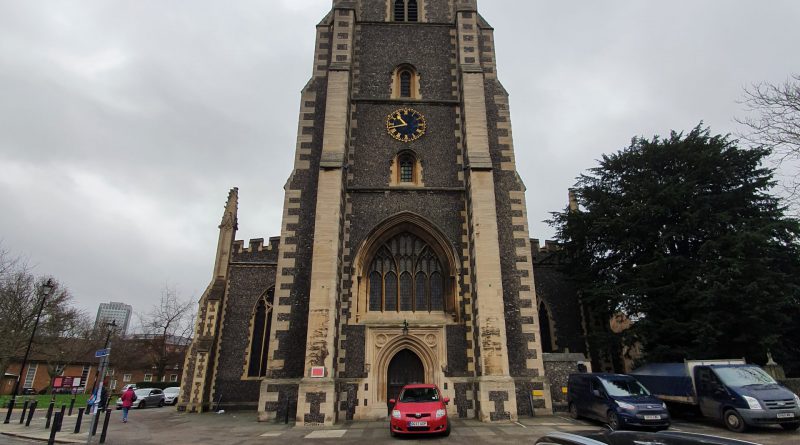London – Croydon (Borough of) – Croydon Minster
I feel I’m in danger of it sounding as if I like everywhere that I go, unless it’s in Croydon. I was hopeful that Croydon Minster would be something which lifted my spirits, but it was shut which wasn’t entirely ideal. However, these are challenging times and I hoped that the exterior would be interesting and intriguing.
My first impressions were a little negative, as I approached the Minster which seemed to be in the middle of a car park. Also, and I can’t think of a similar sized church where this is the case (and I accept that there are likely many), but there were no information boards to help visitors understand the building.
To be fair this isn’t just my view, as a council report (that I’ll mention later) did note about the Minster:
“This is a car-dominated environment that harms the setting of this important asset”.
Well, there was this to be fair, noting that the churchyard was closed down in 1950 and that a war memorial was placed within in it. Interesting, but not entirely what I was hoping for.
Some of the problem is that the road has rather come crashing through in front of the church, as is evident from these two side by side images from 100 years ago and today (clicking on the image makes it larger).
There has been a church here since the Saxon period, so the heritage is undeniable. Unfortunately, there was a substantial fire on 5 January 1867, with much of the interior being lost. That means that the interior is primarily Victorian, but there are six former Archbishops of Canterbury buried here, more than anywhere else other than Lambeth and Canterbury.
This was the nicest photo I could take of the churchyard, or what is left of it. The box tomb is damaged, but the trees add character.
This was the churchyard. I make no comment, which is very restrained of me.
For anyone wondering what happened to the gravestones, clicking on the above image gives a clue. I have to say, I’m not overly impressed with the Church of England here. Someone in the nineteenth century would have likely made great sacrifices to pay for a gravestone for a family member, it would have very likely been something they treasured and would have perhaps thought would have been treated with respect. Knocking it down, cutting bits off to fit and then using it as a paving slab probably wasn’t at the forefront of their mind.
And more paving slabs. The writing has become heavily eroded now, so it’s hard to make out the dates and names on them.
Not wanting to labour a point, but the church clearly wanted to pave as wide an area as possible with their new slabs.
Goodness knows what has happened here.
But, at least Croydon Council has worked out something is wrong here. A report they commissioned a few ago noted:
“When there are services at the Minster the area is tightly jammed with cars. The overall quality of the space is poor and
it does not enhance the setting of the Minster. The subway and associated concrete wall has a negative impact on the character of the area.”
It was added though that the core of the buildings were exceptional:
“The Croydon Minster and the complex of buildings at Old Palace School are Grade I listed, the latter described in the Buildings of England series as ‘one of the best survivals in England of a medieval archbishop’s palace’”.
As for the road plonked in front of the Minster:
“Roman Way is a busy highway located immediately to the west of the Croydon Minster Conservation Area that has a direct impact on its setting, creating a noisy and car-dominated environment.”
The report is one of the most sensible documents that I’ve seen, which did bring me some reassurance. Not much else did about this Minster, I think it’s possibly one of the most depressing churchyards I’ve seen.
And below is how the church looked in 1890, really quite beautiful.













